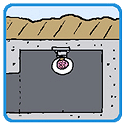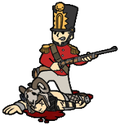|
Koramei posted:Krak des Chevaliers has been damaged in the civil war. I mean I guess that makes sense; just how effective is a thousand year old fortification today? How often does this happen? The whole idea smells of guys in beach sandals firing their aks over their heads
|
|
|
|

|
| # ? May 16, 2024 10:43 |
|
Rent-A-Cop posted:To be fair, Monte Cassino proved that blasting the poo poo out of a castle on a hill doesn't necessarily make it any less of a fortress. Monte Cassino is a hill (Monte is Italian for 'Mount'). And there's no castle on it, there is a monastery.
|
|
|
|
JaucheCharly posted:The whole idea smells of guys in beach sandals firing their aks over their heads What?
|
|
|
|
JaucheCharly posted:The whole idea smells of guys in beach sandals firing their aks over their heads Judging from the countless videos posted on YouTube and elsewhere, the most likely footwear is anything but sandals, and the rifle fire is from the hip at worst. However, the likelihood of it just being ragtag small-arms rebels is about equal to rebels using captured or improvised field pieces. Syria is rapidly becoming Khyber Pass, but churning out garagecraft crew-served weapons in a warzone instead. Every once in a while you see poo poo like a recoilless rifle hacked together from plumbing with a bunch of guys standing around watching some poor labrat bastard timidly firing. Brown Moses would make an incredible post to this end. I wonder if a) the current Syrian Civil War would qualify as relevant, b) there's interest from the thread regulars and c) he's interested in fielding questions. He's more impromptu journalist than historian but he could probably give more detail on what went on at Krak des Chevaliers or any other event over there.
|
|
|
|
I'm up for it. I have a feeling we'll be seeing the repercussions over Syria for decades to come might as well get in on the ground floor right now and save time. Also, Pre WW2 boat chat is pretty awesome.
|
|
|
|
|
Another question about pre-WW2 boats: What effect did the switch from coal to oil have? Is oil-burning that much more efficient than coal-burning? I know that coal was both difficult to bring into a ship and also required a lot of crew to work their rear end off in order to keep the fire stoked, as well as the entire process of coaling at sea being time-consuming and potentially dangerous, but apart from that, is oil an improvement? Turbines were available for both coal and oil-powered ship, so I'm not sure if there is any performance increase when switching from one to the other.
|
|
|
|
Don't underestimate the importance of being able to refuel at sea. It greatly increased the range at which navies could operate, and Japan's neigh-unprecedented ability to refuel their carriers while underway was one of the reasons why the attack on Pearl Harbor was so unexpected, and thus so effective. It was really the only way that the IJN and USN could practice operations across the huge expanse of the Pacific, which would have been impossible with coal-fired ships.
|
|
|
Tekopo posted:Another question about pre-WW2 boats: What effect did the switch from coal to oil have? Is oil-burning that much more efficient than coal-burning? I know that coal was both difficult to bring into a ship and also required a lot of crew to work their rear end off in order to keep the fire stoked, as well as the entire process of coaling at sea being time-consuming and potentially dangerous, but apart from that, is oil an improvement? Turbines were available for both coal and oil-powered ship, so I'm not sure if there is any performance increase when switching from one to the other. http://en.wikipedia.org/wiki/Dreadnought#Fuel I'd think you can also store more oil in a given volume than coal. I would imagine that there would be void spaces between the individual chunks of coal.
|
|
|
|
|
Tekopo posted:Another question about pre-WW2 boats: What effect did the switch from coal to oil have? Is oil-burning that much more efficient than coal-burning? I know that coal was both difficult to bring into a ship and also required a lot of crew to work their rear end off in order to keep the fire stoked, as well as the entire process of coaling at sea being time-consuming and potentially dangerous, but apart from that, is oil an improvement? Turbines were available for both coal and oil-powered ship, so I'm not sure if there is any performance increase when switching from one to the other. Oil is enormously more efficient than coal, about double the heat per pound. So for a given mass of fuel you could go twice as far, and your boilers could also be smaller. Designing oil tanks into a ship is a lot easier than designing coal bunkers into a ship, and oil makes use of space more efficiently (which extends your range even more). Refueling at sea became practical, as did oilers to do it with so that you didn't need a global network of coaling stations. And not only do you not need to exhaust your entire crew in regular recoaling operations, you reduce manning requirements since you don't need all those stokers anymore. You become less visible at sea because you're not emitting huge clouds of coal smoke. Ships that could operate on both might see a performance increase of as much as several knots, but there are other limiting factors; maximum speed is typically limited by the engines themselves, designed to operate at a given steam pressure. Just changing the fuel doesn't increase that. Speaking of protected cruisers, the Olympia's still tied up in Philadelphia. The museum's trying to unload it because they can't afford the maintenance: it's been sitting in the water since 1945 and desperately needs maintenance. It's a shame because the interior of the thing looks like this:     
|
|
|
|
Not to mention coaling stations required long multi-mode supply lines, and with that came susceptibility to attack and the threat of handing over usable resources to the enemy. Bring dedicated fuel ships with your carrier groups and not only do you extend their range but you deny the enemy the ability to recover resources from a naval victory. They aren't going to try slurping an oil slick off the surface only to have to reprocess the water out of it. You can effectively hide in the sheer emptiness of either ocean, an air-capable battlegroup might have a detection area measured in tens of thousands of square miles at best, compared to millions of square miles of open water. Hell, you can refuel at night (barring the threat of bioluminescent plankton) and do it comparatively under the enemy's nose. Modern radar, air range, and satellite capability make it harder, but as evidenced by the recent Malaysian Airlines crash it's still hard as all hell to find something in the ocean even if it's brightly colored and gave several hints before disappearing.
|
|
|
|
Tekopo posted:Another question about pre-WW2 boats: What effect did the switch from coal to oil have? Is oil-burning that much more efficient than coal-burning? I know that coal was both difficult to bring into a ship and also required a lot of crew to work their rear end off in order to keep the fire stoked, as well as the entire process of coaling at sea being time-consuming and potentially dangerous, but apart from that, is oil an improvement? Turbines were available for both coal and oil-powered ship, so I'm not sure if there is any performance increase when switching from one to the other. Another part of oil being significantly more energy dense is that for a while coal fired ships were rigged to spray their coal with oil to enable higher speeds. The other huge point about the switch to oil is that oil fields aren't in the same places as coal, which had some pretty huge ramifications strategically.
|
|
|
|
Krak des Chevaliers makes sense as a military target even today, as it's situated on the dominant hill in the area. Always take the high ground! Also, it makes for a swanky base of operations.
|
|
|
|
Alchenar posted:Monte Cassino is a hill (Monte is Italian for 'Mount'). And there's no castle on it, there is a monastery.
|
|
|
|
Rent-A-Cop posted:Monte Cassino was also a battle wherein artillery blasted the poo poo out of that monastery. Turning a big stone building into a big stone rubble pile doesn't really make it all that much worse as a defensive position. Modern precision artillery could certainly make defending a spot like Krak des Chevaliers untenable, but the Syrian Army doesn't have access to modern artillery. It does kill everyone in the defensive position though. If you let enemy troops back into the rubble after you shell it then you have a problem because you now have to combine urban combat with earthquake disaster recovery, but everyone in a castle when it gets shelled is going to die.
|
|
|
|
Alchenar posted:It does kill everyone in the defensive position though. If you let enemy troops back into the rubble after you shell it then you have a problem because you now have to combine urban combat with earthquake disaster recovery, but everyone in a castle when it gets shelled is going to die. To illustrate the point in Monte Cassino the opening bombardment killed some 250 people, half of the cca 500 refugees and monks living there (there were no German soldiers there at that moment - they came once the place had already been reduced to rubble). I don't think castles in Syria are under threat of such intense, concentrated destruction, though. And they should be good enough at protecting from small arms and other light weapons. steinrokkan fucked around with this message at 22:46 on Mar 24, 2014 |
|
|
|
Alchenar posted:It does kill everyone in the defensive position though. If you let enemy troops back into the rubble after you shell it then you have a problem because you now have to combine urban combat with earthquake disaster recovery, but everyone in a castle when it gets shelled is going to die.
|
|
|
|
Doesn't this reset the record for the longest period between a fortification first being built and it being last used for warfare? It's pretty badass that a crusader-era castle still gets some time in the sun, but also pretty tragic that a priceless piece of history is being smashed apart over some bullshit.
|
|
|
|
|
It was built over some bullshit too. This also isn't going to be its last use in warfare.
|
|
|
|
As long as we're not losing the good bits of history.
|
|
|
|
The Theodosian walls hold a longer record; erected in the 5th century, breached for the first time in the 15th. Assuming you don't count the 12th crusade, and they basically cheated. And the Ottomans kept them all the way until the Industrial Revolution but I dunno if Constantinople ever came under threat again? And it wouldn't surprise me if there are some that lasted even longer in China, some of those city fortifications are absolutely insane.
|
|
|
|
Dubrovnik's walls were first built in, uh, I want to say 1000 AD or so, and they held up to a siege during the 90s.
|
|
|
|
The stretch of the Great Wall of China running from Shanxi to the Shanhai Pass was built in the 6th century and used repeatedly during the 20th century (Zhili-Fengtien wars, Inner Monglian wars). In 1933 it saw very substantial action when it became the battleground for cca two hundred thousand men, and proved itself to be a very good defensive asset: http://en.wikipedia.org/wiki/Defense_of_the_Great_Wall
|
|
|
|
steinrokkan posted:The stretch of the Great Wall of China running from Shanxi to the Shanhai Pass was built in the 6th century and used repeatedly during the 20th century (Zhili-Fengtien wars, Inner Monglian wars). In 1933 it saw very substantial action when it became the battleground for cca two hundred thousand men, and proved itself to be a very good defensive asset: http://en.wikipedia.org/wiki/Defense_of_the_Great_Wall Except that that bit, along with most of what we think of as The Great Wall today, was rebuilt by the Ming in the 15th century.
|
|
|
|
PittTheElder posted:Except that that bit, along with most of what we think of as The Great Wall today, was rebuilt by the Ming in the 15th century. Well, Dubrovnik has been rebuilt too in various centuries, and the city gates come from 15 -17 century, with one added in 20th.
|
|
|
|
Rent-A-Cop posted:Monte Cassino was also a battle wherein artillery blasted the poo poo out of that monastery. Turning a big stone building into a big stone rubble pile doesn't really make it all that much worse as a defensive position. Modern precision artillery could certainly make defending a spot like Krak des Chevaliers untenable, but the Syrian Army doesn't have access to modern artillery. Does anyone remember in the old thread where someone posted something to the effect of in the second WW, infantry units preferred to not have to attack urban places that had been reduced to ruins? I think the general gist of it was that when you have windows and doors to shoot from the enemy is pretty limited by their lines of sight and therefore easier to locate but when you turn everything to dust, the places you can return fire from are far greater. Could be misremembering!
|
|
|
|
AdmiralSmeggins posted:Mao: The Unknown Story by Jung Chang and Ian Halliday. Jung Chang has an ossuary to pick with Mao. Of course, that doesn't mean that she's wrong. Most certainly some of her assertions about his economic policy (being complete garbage) have been borne out by other scholarship.
|
|
|
|
quote:Ancient forts being used in modern combat I would imagine there's ancient forts all over the Mideast that were used as defensive positions during one war or another. Or India/Pakistan. Or Greece/Turkey - I would wager there were tons of this kind of thing in WWI/II. E: Aurelian walls in Rome: Built 3rd century C.E. and used as defensive works clear up into the late/mid 19th c. FAUXTON fucked around with this message at 03:36 on Mar 25, 2014 |
|
|
|
Koramei posted:The Theodosian walls hold a longer record; erected in the 5th century, breached for the first time in the 15th. Assuming you don't count the 12th crusade, and they basically cheated. And the Ottomans kept them all the way until the Industrial Revolution but I dunno if Constantinople ever came under threat again? Hey, treachery is tried and true, it's gunpowder that is the true cheating.
|
|
|
|
Frostwerks posted:Does anyone remember in the old thread where someone posted something to the effect of in the second WW, infantry units preferred to not have to attack urban places that had been reduced to ruins? I think the general gist of it was that when you have windows and doors to shoot from the enemy is pretty limited by their lines of sight and therefore easier to locate but when you turn everything to dust, the places you can return fire from are far greater. I think it was an awful slog either way. The preferred way of urban warfare was to avoid using doorways and windows at all. At Aachen, the Americans brought out Tank Destroyers and SPGs as direct-fire artillery, and slowly leveled the town while the infantry moved in afterwards. The rubble could have been used as cover, but there wasn't usually anybody still around in the wrecked buildings who could re-occupy them. At Ortona, the Canadians avoided streets entirely. They knocked holes into the sides of buildings, and doused the interior with grenades before entering. I guess you can't do that if the entire place is in bits. Do note that the average European building was sturdy you needed direct hits, or very large ordnance to reduce to a pile of something. Le Havre was a town that was totally ruined, but that was after a long-sustained air campaign and two days of 15-inch shells from the Royal Navy.
|
|
|
Slavvy posted:Doesn't this reset the record for the longest period between a fortification first being built and it being last used for warfare? http://www.navy.mil/submit/display.asp?story_id=67955 Allegedly built in some indeterminate time period between Alexander the Great and the 18th century.
|
|
|
|
|
Frostwerks posted:Does anyone remember in the old thread where someone posted something to the effect of in the second WW, infantry units preferred to not have to attack urban places that had been reduced to ruins? I think the general gist of it was that when you have windows and doors to shoot from the enemy is pretty limited by their lines of sight and therefore easier to locate but when you turn everything to dust, the places you can return fire from are far greater. Antony Beevor mentions that when the Germans bombed Stalingrad into ruins it perfect defensive terrain.
|
|
|
|
Slim Jim Pickens posted:I think it was an awful slog either way. Oh I know that the attackers tried to avoid doors and windows. I think they we were using M1 beehive rounds over in Iraq for dynamic entry and the US Army has been using dynamic entry since at least the Mex-Am War so that isn't new. I meant that before the town got leveled (back in WW2) the defenders who occupied buildings lines of sight were far more predictable because they were limited to the placement of architectural apertures. But you put mortars and heavier ordnance on tops of buildings and suddenly you got a place for snipers or machine gun teams. Or you thump with side of a troublesome house with 75 or 76 mm and if it doesn't kill dead everything in the room now you've got another entrance- but they've got another place to shoot or exit from. I hope this isn't getting into that weird Israeli commander citing Deleuze in his theory on urban combat but I think that's what they were getting at. If it makes any difference I believe that the post was from British infantry's dislike of having to assault towns that had been blown to bits if that helps at all. Truth told I'd really have to find that old post in the old thread but man... that thing is a beast.
|
|
|
|
Frostwerks posted:Oh I know that the attackers tried to avoid doors and windows. I think they we were using M1 beehive rounds over in Iraq for dynamic entry and the US Army has been using dynamic entry since at least the Mex-Am War so that isn't new. I meant that before the town got leveled (back in WW2) the defenders who occupied buildings lines of sight were far more predictable because they were limited to the placement of architectural apertures. But you put mortars and heavier ordnance on tops of buildings and suddenly you got a place for snipers or machine gun teams. Or you thump with side of a troublesome house with 75 or 76 mm and if it doesn't kill dead everything in the room now you've got another entrance- but they've got another place to shoot or exit from. I hope this isn't getting into that weird Israeli commander citing Deleuze in his theory on urban combat but I think that's what they were getting at. If it makes any difference I believe that the post was from British infantry's dislike of having to assault towns that had been blown to bits if that helps at all. Truth told I'd really have to find that old post in the old thread but man... that thing is a beast. This warrants more explanation.
|
|
|
|
the JJ posted:This warrants more explanation. http://www.frieze.com/issue/article/the_art_of_war/ FWIW, I know it was said in the old thread and I wouldn't be surprised if it's popped up in this one, but I think it really was just that one guy with a hardon for postmodern French philosophy.
|
|
|
|
The Merry Marauder posted:3" was acceptable for the very brief period (certainly over before WWI began) where weak torpedo boats were doctrinally expected to attack separately from the rest of a force. Otherwise, unshielded, unprotected guns would be...difficult to work with the main batteries firing, not to mention hauling shells to the initially absurd (in context) positions of the 12 pounders. The Royal Navy's anti-torpedo boat armament (secondary armament isn't really the correct term for these guns, for reasons that I can expound on ad nauseum but which would just bloat up this post) choices prior to 1914 were something of a clusterfuck to say the least. Fisher picked the 12 pounder for the Dreadnought and the Invincibles because that was what the most modern British destroyers were using at the time. Fair enough. Problem was, destroyers were getting bigger and by 1906, when Dreadnought began her trials, the 12 pounder was rather anemic (Also the early Dreadnoughts had their anti-torpedo battery pretty poorly located, mostly on top of the main turrets. Reasonable if you're expecting to beat off an enemy flotilla operating by itself, useless in a fleet action because of what the blast from the main guns would do to the gun crews on the turret roofs). So they upgraded to the 4 incher. Again, fair enough. Then in 1911 it's decided to upgrade again to the 6 inch gun, which for safety's sake will be put in armored casements to keep the gun crews from getting wiped out in a fleet action (in fact there's an argument that the casemates made things worse by creating a long enclosed gallery that could see all the guns knocked out by one sufficiently damaging hit like the Malaya suffered at Jutland). Problem was that the forward-most casemates ended up getting flooded out in anything other than a glassy sea and the 6 inch shell turned out to be too heavy for easy manual reloading. After World War One things got even worse because unlike the U.S. Navy the British could never be bothered to come up with a single dual-purpose medium gun like the American 5"/38. The closest they came was the 5.25", but the mounting used for that weapon was hideously complex and hard to get working correctly. British destroyers and other ships of the 1930s and 40s ended up saddled with a bewildering variety of 4", 4.5", 4.7", 5.5", and 5.25" guns that often couldn't share mountings or ammunition with other guns of the same caliber.
|
|
|
|
Though I seriously doubt any Israeli IDF commander is going to be citing Reza Negarestani.
|
|
|
|
ALL-PRO SEXMAN posted:Reasonable if you're expecting to beat off an enemy flotilla operating by itself, useless in a fleet action because of what the blast from the main guns would do to the gun crews on the turret roofs). Yeah, "...difficult" was meant to be a humorous euphemism for "splatty." ALL-PRO SEXMAN posted:After World War One things got even worse because unlike the U.S. Navy the British could never be bothered to come up with a single dual-purpose medium gun like the American 5"/38. The closest they came was the 5.25", but the mounting used for that weapon was hideously complex and hard to get working correctly. British destroyers and other ships of the 1930s and 40s ended up saddled with a bewildering variety of 4", 4.5", 4.7", 5.5", and 5.25" guns that often couldn't share mountings or ammunition with other guns of the same caliber. I don't know that I would equate the 5.25 and the 5"/38, but YMMV. I think the 5.25 tried to be too much of a traditional secondary, resulting in a rather a slow AA gun, the remarkable successes of HMS Ulysses notwithstanding. 4.5" was largely the way to go, but there's only so much budget and so many ships to refit. This does mean you get funny things like the 5 QEs having 4 different levels of capability by WWII. It taking so long to switch the destroyer armament away from 4.7s is unfortunate, as well. It would be remiss of me not to acknowledge that the success of US AAA would not have been possible without superior fire-control, RPC, VT, etc. The Merry Marauder fucked around with this message at 07:07 on Mar 25, 2014 |
|
|
|
Rodrigo Diaz posted:I'm very familiar with it, and will write a bit about it when I get home. Don't forget about this, I'm still interested!
|
|
|
|
Handsome Ralph posted:Don't forget about this, I'm still interested! Oh man, definitely echoing this sentiment.
|
|
|
|

|
| # ? May 16, 2024 10:43 |
|
Koesj posted:NATO as a military force in Cold War West-Germany, or in Europe as a whole for that matter, was under the command of Allied Command Europe, with, as was hashed out during NATO's formation, a US 4 star general at its head. He would indeed get the political green light from the NATO Council to meet a major contingency by means of a pretty well integrated multinational force. Hey so im like on pge67 and i dunno if this post ever happened but bro you should totally make it happen
|
|
|






























 Yes, it's like a lava lamp.
Yes, it's like a lava lamp.








